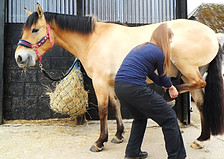Rest
WHAT IS VETERINARY PHYSIOTHERAPY?
Veterinary physiotherapy is a science based and manual approach to maintain, optimise and enable the recovery of your animal after an injury or surgery. The main aim is to relieve pain, improve proprioception, even muscle mass, restore free, independent movement and improve your animals wellbeing for the long term. Physiotherapy may be defined into two categories; physiotherapy for treatment of injury and physiotherapy for maintenance and prevention of injury.
Your vet is the sole professional who can diagnose and prescribe treatment of an animal, under 'The Veterinary surgeons act 1966' a Veterinary referral is required before the physiotherapist can treat your animal for injury. A referral form is available for download from this site (please see our home or services page). To ensure your animal is able to receive the best care, an owner consent form is also needed to enable the physiotherapist to liaise with the vet as required.

Electrotherapies
What happens in a session?
Veterinary Physiotherapy involves a thorough assessment of the animals current life style/exercise routine, previous injuries, diet and breed. A visual and manual assessment will then be made to formulate a clinically reasoned treatment plan that may combine manual/electrotherapies with remedial exercises targeted to the individual. After the session the VP will write up and send a veterinary report to ensure the veterinarian and yourself are updated with the received therapy and progress of your animals musculoskeletal health.
In between physiotherapy sessions, the owner may be given a therapeutic exercise plan after guidance from the VP, to optimise the treatment and ensure the animal maintains optimal comfort in the long term. This could be anything from massage techniques, laser therapy, heat packs or prescribed exercises.





STEP 1: STATIC AND DYNAMIC ASSESSMENT
This is where the therapist will make a visual assessment of your animal whilst standing and moving. To make sure there is enough space to make an accurate assessment this may need to be done outside on a flat surface, as an owner this is where you get involved to handle your animal and trot them up - cats may be best enticed towards a toy/ treat.
STEP 2: PALPATION
The therapist will then palpate the animal to detect any areas of pain or tension.
Understanding the tissue state and degree of discomfort is greatly important to be able to clinically reason which manual techniques or electrotherapies will best suit the type and state of tissue.
STEP 3: RANGE OF MOTION (ROM)
ROM assesses each joint and surrounding tissues to understand their current level of function, it also assesses any tissue restrictions that may need addressing. This will be performed each visit to monitor any changes to the joints or tissue.
STEP 4: CLINICAL REASONING FOR TREATMENT
Once the static and dynamic assessment, palpation and ROM has been carried out, the physio will then clinically reason the treatment plan based on the treatment categories below:
AFTER ASSESSMENT - STEP 5: TREATMENT
Once clinically reasoning the key areas to work on your pet, your treatment plan will be formulated with a range of techniques from the treatment categories below. To find out more information about these treatment categories go to our services page.
-
Manual therapies
-
Electrotherapies
-
Remedial exercises
-
Rest



